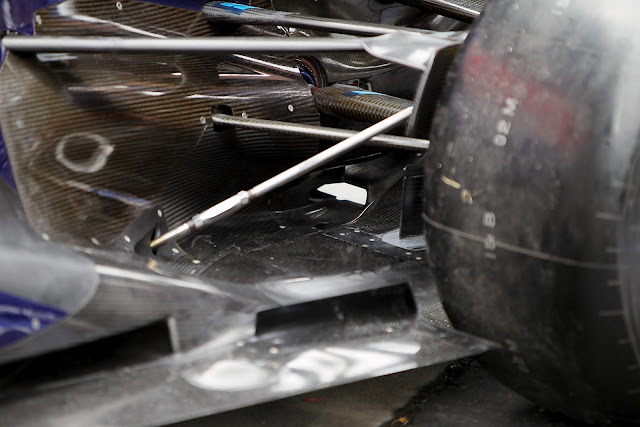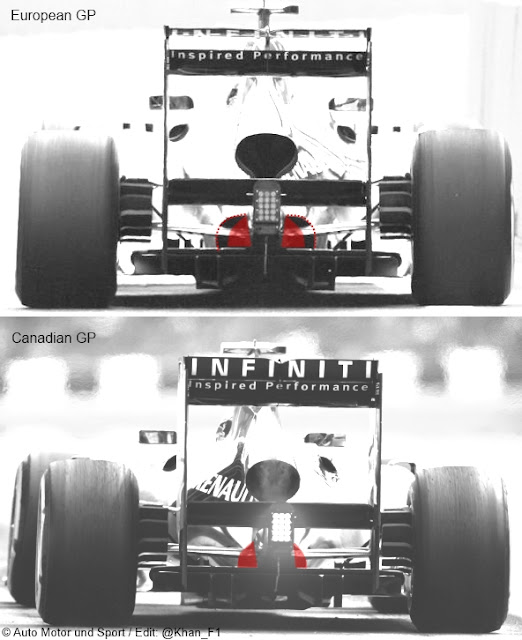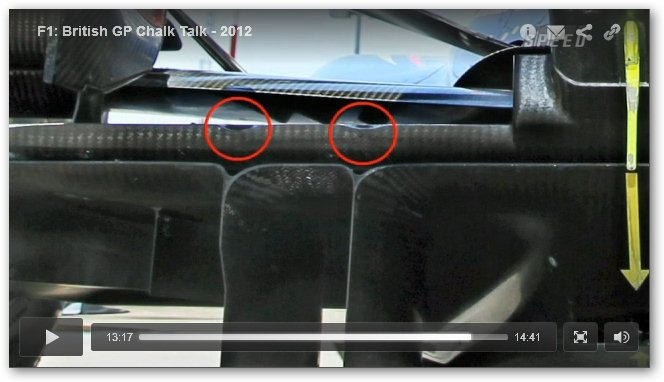
Diffuser blowing in 2012
#1

Posted 05 July 2012 - 12:13
Advertisement
#2

Posted 05 July 2012 - 16:40
Interesting in the sense that it is mostly bollocks? Cylinder deactivation by cam control during safety car? WTF?Interesting read on diffuser blowing this season.
http://somersf1.blog...lowing-via.html
#3

Posted 05 July 2012 - 17:12
Interesting in the sense that it is mostly bollocks? Cylinder deactivation by cam control during safety car? WTF?
#4

Posted 05 July 2012 - 17:45
#5

Posted 05 July 2012 - 20:19
Edited by MatsNorway, 05 July 2012 - 20:19.
#6

Posted 06 July 2012 - 06:14
Variable cam timing was banned in the late nineties or earlies 2000s as I recall. I worked on a controller for a system which was tested on an F1 engine in the mid nineties but there turned out to be little benefit using it. A bit more low RPM torque for a lot of R &D expense.Actually i think its not allowed with variable cam anything when you mention it.
#7

Posted 06 July 2012 - 11:50
Variable cam timing was banned in the late nineties or earlies 2000s as I recall. I worked on a controller for a system which was tested on an F1 engine in the mid nineties but there turned out to be little benefit using it. A bit more low RPM torque for a lot of R &D expense.
Interesting. so having two cams for mid to high rpm would not give much of a gain? so it wasn`t just the "wrong" cam profile on the secondary (or what you called it) cam?
Would it have a bigger gain in modern fuel efficient racing?
The blog is not much worth on other topics either, he claims that a drivehaft generates lift (either a typo or a lack of understanding) But he got some good pictures and notes from the development.
Such as this one where they have covered the driveshaft on the red bull. Perhaps it disturbs the laminar airflow?


http://somersf1.blogspot.co.uk/
Edited by MatsNorway, 06 July 2012 - 11:56.
#8

Posted 06 July 2012 - 12:42
Interesting. so having two cams for mid to high rpm would not give much of a gain? so it wasn`t just the "wrong" cam profile on the secondary (or what you called it) cam?
Would it have a bigger gain in modern fuel efficient racing?
The blog is not much worth on other topics either, he claims that a drivehaft generates lift (either a typo or a lack of understanding) But he got some good pictures and notes from the development.
I think when they talk about "variable cam timing" I suspect they mean just simple "phasing" - varying the angular position of a conventional camshaft - phasing has little effect on outright power.
I would imagine that a genuine variable duration system like VTEC or (dare I say it) the Helical Camshaft would probably be very advantageous (if either system could be made to operate reliably at F1 engine speeds).
As GG pointed out a while back - a rotating driveshaft would actually produce downforce, not lift.
#9

Posted 06 July 2012 - 19:33
Cylinder Deactivation has been being used in F1 for a number of years, here's a topic from way back in 2008 where the very subject was under discussion but the Tech had been there for years before that:
<a href="http://www.f1technical.net/forum/viewtopic.php?f=4&t=5973&start=15" target="_blank">http://www.f1technical.net/forum/viewtopic...73&start=15</a>
It's use in road cars of today is effectively a general hand down from it's continued use in Motorsport although it's origins lie in the Cadillac of the early 80's. Although I refer to the camshaft controlling the Cylinder Deactivation I would say that in F1 it is more likely electronically controlled via Spark and Fueling and unfortunately I made a sweeping generalisation in order to help people understand with the use of that video. (Perhaps I should edit that paragraph)
I did start out by saying that this is a theory too and although it's plausible CD is being used there is obviously other things that could be in play too.
In regard to my comment about the Magnus Effect creating 'Lift':
Encloses the driveshaft, this removes the Magnus Effect on the exterior airflow. The Magnus effect can create lift something you want to reduce in this area as it will have an impact on the air you are trying to generate downforce with. More importantly though due a massive boundary layer build up it can create a huge chunk of drag too. Not being able to divert the exhaust gases in a precise manner means you would like to control the airflow aft of the exhausts as much as possible. Reducing the effects of this spinning element from the equations especially in such a critical area may be a shrewd move by Red Bull.
I did use the word 'can' create lift, if the driveshat was rotating in the opposite direction it would create lift. I'm simply questioning Red Bull's tactic of shrouding the driveshaft whilst others haven't. I'm putting this down to the exhaust plume altering the usual stagnation point enough to warrant the shroud and losing the usual 'downforce' the driveshaft could create. Afterall when using the exhaust plume to manipulate the airflow in that region it is no longer a laminar flow and the shroud in combination with the floor and strakes create a controlled environment above the diffuser.
Edited by Matt Somers, 06 July 2012 - 19:35.
#10

Posted 06 July 2012 - 19:58
Edited by saudoso, 06 July 2012 - 20:05.
#11

Posted 06 July 2012 - 21:29
#12

Posted 06 July 2012 - 22:12
I thought he was saying that without the shroud, the overall car would be getting less downforce. In other words, lift. Yes, this is still semantics, but it's different semantics than what you're talking about. He's talking about the overall effect on the car, not on the driveshaft itself.
If you put a vertical plate covering the whole of the rear wing, you will block it and the wing will cease creating downforce. But it won't be creating lift.
#13

Posted 07 July 2012 - 02:43
#14

Posted 07 July 2012 - 19:30
Can anybody tell me what the 4 spray holes in the spray rail do and why they are lined up with the diffuser strakes ?
Many thanks.
#15

Posted 07 July 2012 - 20:03
Can't see the video, got any screenshots?http://www.speedtv.c...2295001/1#_vtop
Can anybody tell me what the 4 spray holes in the spray rail do and why they are lined up with the diffuser strakes ?
Many thanks.
Edited by OwenC93, 07 July 2012 - 20:09.
#16

Posted 07 July 2012 - 21:30
It seems it has to be hypertext link.
Sorry,
#17

Posted 07 July 2012 - 22:32
that said laminar airflow is a definition question. there might be turbulent air out from the exhaust but there might be a relative laminar airflow a meter behind it. And the driveshaft disturbs it. that might be what red bull is doing.
i still find it strange considering that the driveshaft is in the midle.. and they still supposedly gets gains from it.
disclaimer: post made after a few drinks.
#18

Posted 07 July 2012 - 23:11
Also I dont see how cylinder deactivation helps off throttle blowing.
Can't see the video, got any screenshots?

#19

Posted 08 July 2012 - 00:50
Advertisement
#20

Posted 08 July 2012 - 02:04
#21

Posted 08 July 2012 - 15:58
What redbull is doing there is to increase the angle of the diffuser to the ragged egde of whats possible. Then they lower the section with the umm steering plates/fins/guiding vanes or what ever they call them. because they stalls at a different speed.
Just me guessing ofc.
And since they allready duct air from the sides who would not be as effective as a direct path. i start to wonder if they will duct from the front next year. Like i suggested last year.
http://imageshack.us...s/42/merc2.jpg/
That would be funny to see.
#22

Posted 08 July 2012 - 16:06
What redbull is doing there is to increase the angle of the diffuser to the ragged egde of whats possible. Then they lower the section with the umm steering plates/fins/guiding vanes or what ever they call them. because they stalls at a different speed.
Cahterham goes about their top of the diffuser differently. they have a small gourney on the top of the diffuser with small cutouts for the vanes.
Just me guessing ofc.
And since they allready duct air from the sides who would not be as effective as a direct path. i start to wonder if they will duct from the front next year. Like i suggested last year. http://imageshack.us...s/42/merc2.jpg/
That would be funny to see.















